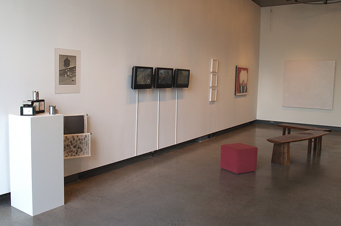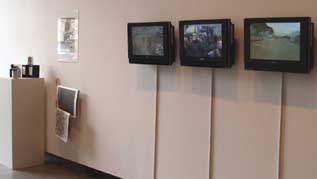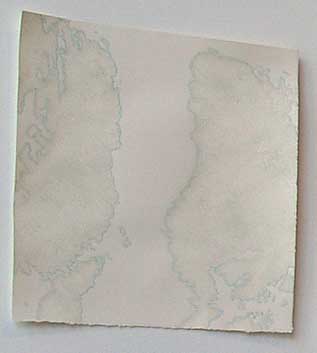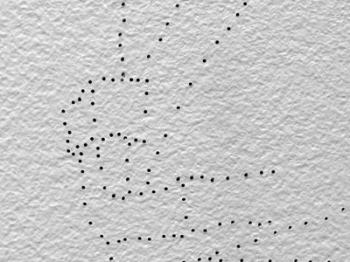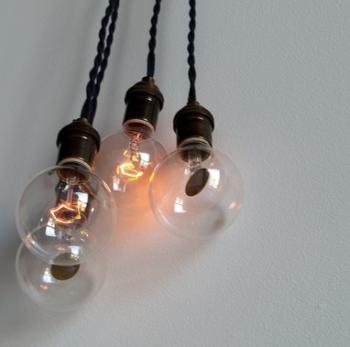
|
||
|
Portland art blog + news + exhibition reviews + galleries + contemporary northwest art
|
||
Talking With Ghosts: invisible.other at NAAU
TJ Norris, a local artist and curator, has put together a subtle but stimulating group show at the New American Art Union. The title of the show is invisible.other, and it seems like the work deals with the transient way that people inhabit spaces. The gallery is full things that suggest absence as much as presence. Sometimes there are artifacts like windows and light bulbs; at other times there are maps or drawings of a landscape but presented in a way that suggests an absent human presence. Invisible.other is a fitting title for the show because most of the work details with a residual human presence in the people and things that we encounter and leave behind. Walking through the show we are presented with ideas that slip away as soon as they come into focus, like passing by a person on a crowded street.
German media artist Thomas Koner's video piece Periphiques reminds me of ghosts, except these are not ghosts in a haunted mansion but the people we pass on the street everyday and never notice. The 3- channel installation consist of video monitors of three different distances that we might encounter people (shot in Ethiopia, Serbia, and Argentina). In the close up of people walking on a crowded sidewalk the faces blur into one another, stripped of any individual identity. In the other monitors they might be nothing more than one of many shapes moving from one place to another. Because the videos are so impersonal, we never really get to know anything about the people in any of them, and it creates a dark, detached mood that I think is a central element of the video. The faces and bodies all become interchangeable, blending from one person into the next. It makes you realize just how transient we are in the spaces that we inhabit. When we walk through crowded streets, maybe all we are is just another blur in someone else's peripheral vision. We are reminded that we are often completely ephemeral, like ghosts except in the traces we leave behind. Laura Vanderburgh's suite of mythical landscape drawings that begin the show are great. Who knew water tables could be so beautiful? Parts of the drawings were a little unexpected. I often thought I was looking at pretty straight forward geological forms but then it would transform so that I really felt like I was looking at the surface of a person's skin. Maybe the drawings are a meditation on the topography of the human body or perhaps a whole new meaning for Mother Earth. I was surprised with Melia Donovan's (a PORT writer) drawing Frostie Freeze. If you come at the drawing from an angle it disappears and becomes visible again only if you look at it head on. The drawing is made up of hundreds of little holes in the wall that describe a Frostie Freeze drive in. The holes give the drawing a wonderful flatness that is undermined by the one point perspective of the image. It makes you wonder if the holes that she puts into wall create the drawing or if the holes are somehow assembled in our minds to create a coherent image. Because the holes are actually three dimensional, the drawing has the ability to track you as you move through the space by slowly becoming visible and then invisible, turning on and then off. One part of Idaho artist Ted Apel's Potential Difference, is a picture frame with pictures of two inventors (one being Thomas Edison) and including descriptions of their inventions in two languages. Next to the frame is the other part of the piece in the practical application of their inventions demonstrated in four light bulbs. Two of the bulbs conduct electricity to produce visible light and two bulbs produce sounds. It is a beautiful installation because in a very simple way we are taught that the bulbs are producing these effects by vibrating in different frequencies. These frequencies might be in the spectrum of visible light or they could be in a range that we can only experience with our ears. The piece draws an interesting connection between visual and audio art. It suggests the possibility of the two being potentially very similar but just in different frequencies. The whole piece takes on the quality of something you might find in a science museum. Ty Ennis' drawing I disappear into you, is of strange landscape with a pair of empty shoes in the foreground. It is very beautiful to look at but not necessarily a place you want to go for a Sunday stroll. I think the shoes in the foreground sort of reinforce that idea if you go in, you don't come out. I was hoping for more from Washington D.C. based artist Richard Chartier's three small paintings on panel Reference 1,2,3. It was hard to get around the Cy Twombly/ Robert Ryman aesthetic and to find out what he was trying to do. The drawings are mostly white acrylic over small (colored?) pencil shapes along the border. It was a little disappointing because Richard is a good artist but in these paintings he doesn't contribute any new ideas to what artists are already working on in Portland. Most of the work in the show is worthwhile but a few of the pieces don't add anything and so the result sometimes gets a little a crowded. It is almost like too many people (ghosts?) talking all at once. If you want to get outside of yourself or if you want to look at the things around you in a new way be sure to check out invisible.other at the New American Art Union, which will be up until the end of April. New American Art Union invisible.other is up until the end of April
Posted by Arcy Douglass on April 18, 2007 at 23:38 | Comments (0) Comments Post a comment Thanks for signing in, . Now you can comment. (sign out)
(If you haven't left a comment here before, you may need to be approved by
the site owner before your comment will appear. Until then, it won't appear
on the entry. Thanks for waiting.)
|
| s p o n s o r s |
 |
 |
 |
 |
 |
 |
 |
 |
 |
 |
 |
 |
 |
 |

|
Site Design: Jennifer Armbrust | • | Site Development: Philippe Blanc & Katherine Bovee | |


